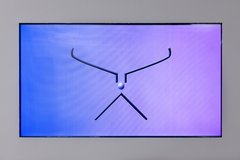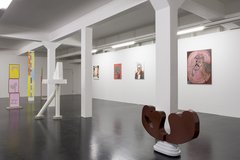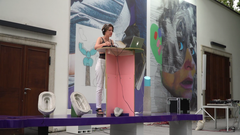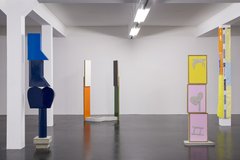This is the story about the meeting between Maruša Sagadin’s previous exhibition, She in Caps, and Sagadin’s new exhibition at Künstlerhaus, Halle für Kunst & Medien.
After molting into a new form in the world, SHE decides to visit the host of the new center of attention, in her desperate desire for immortality.
Milli Vanilli becomes Sarcastic Professional in the Wu-Tang Name Generator
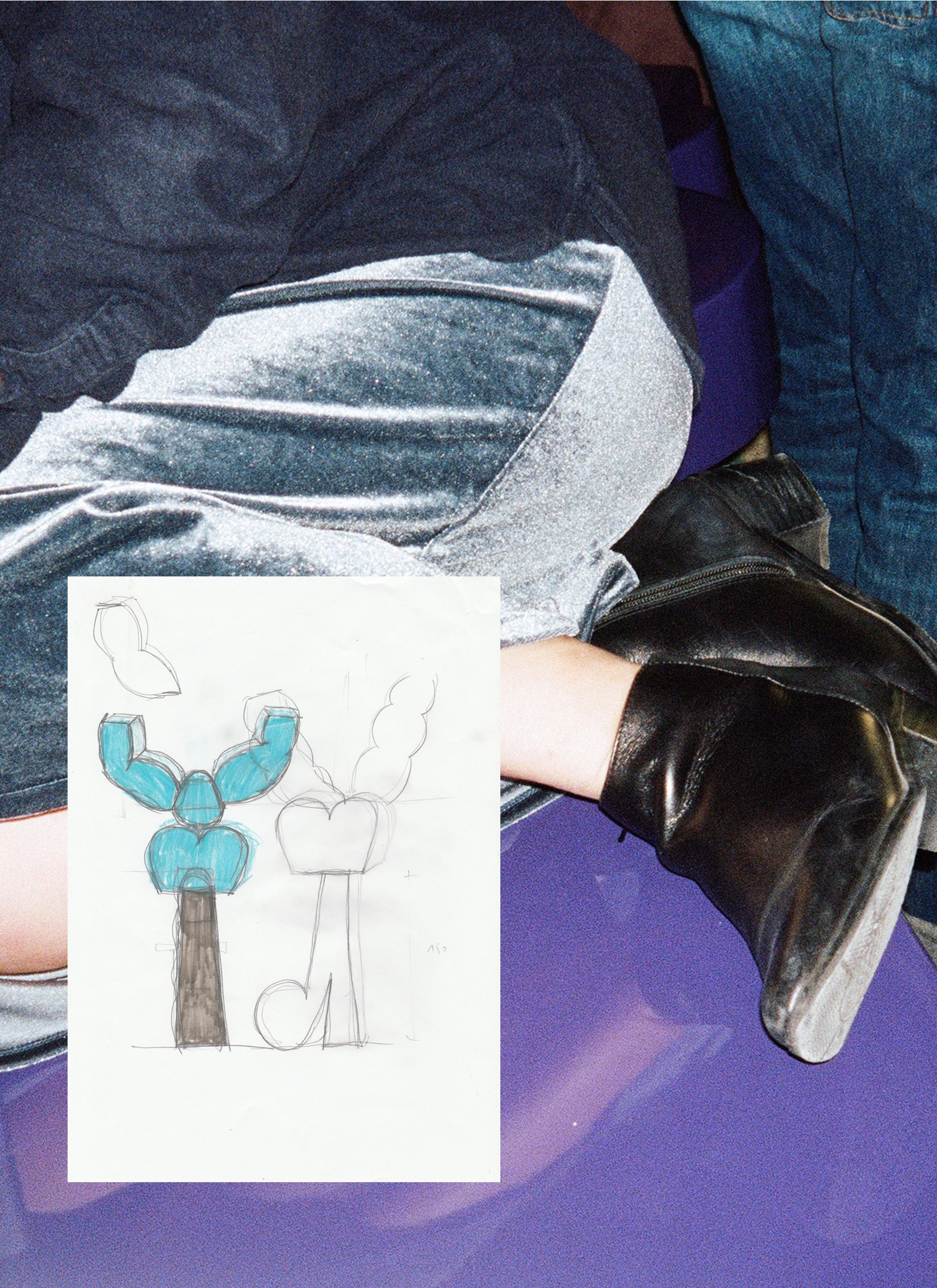
Doris met her outside when she arrived. Doris was indeed an iconic ionic. She was a mutated column sliding through space: collapsed and wavy; carrying make-up, accessories, and historical leftovers of Zaha Hadid. Like a skyline, she presented the wearable architectural models to her visitors, inviting them to sit down among the clouds of the city.
Her glossy, purple paint on top of the wooden structure competed with the darkness of the night that slowly tried to swallow her. But she was a public figure used to the behavior of the unforeseen. She could handle the darkness.
Doris almost favored challenges that could endanger her smooth surfaces. With a nearly sadomasochistic pleasure, she relished it when people used her, sat on her, danced on her, and performed gestures that resisted the permissions and rules of public space.
But people were always gentle.
Doris’s favorite part of being outside was to watch when it snowed so heavily that the marks of zebra crossings and other signs of infrastructure disappeared in traffic. For a moment mechanical and controlled movements vanished from the public space.
It made people behave differently.
There was some kind of freedom attached to the new, emerging gestures. It was as if some special solidarity arose among strangers, for people suddenly noticed one another when they weren’t following traditional paths and rules.
She observed the same meetings and conversations when strangers sat down on her.
Doris had an aura of kindness about her. She was an invitation to create an intimate space, while SHE occupied and surrounded space.
SHE was space.
No words could really pass through her form to understanding.
No human was able to see her with the naked eye. SHE was like a mirage—the wavy lines you see hovering over a sunny road on a hot, steamy day, when the air is layered in different densities so that it resembles water on the road. SHE was like a transparent wall of liquid containing every possible color within her, like a psychedelic pattern. SHE was an abstract symbol of all the objects and colors that used to belong to her. Like an exploded tie-dyed tee.
The subverted column looked almost humble next to her fourth-dimensional form. There was something irresistible about the necklace, lipstick, and O2 Shoes on top of Doris. Placed between definitions, their sizes were too cute to be architecture and too clumsy to be accessories.
They were unbearable and unwearable, and at the same time they put up a façade.
Before SHE entered the building, SHE put on the lipstick and licked the blue surface of the little skyscraper. She watched to see if Doris cared. She did. A seductive element of hers had changed. No longer an object in between definitions, the little skyscraper was now pure cement, a fragile element leaning on Doris’s lap. SHE had always wanted the little lipstick building to be part of her. Since it was too late—because SHE did no longer exist physically—SHE preferred that it belong to no one at all.
Doris was made of the same materials SHE would find in the objects of the exhibition inside. Doris was the link between the outside and the white cube on the inside and therefore also the link to The One that SHE came to meet.
It was time to move inside. Down to the basement, which was the why reason SHE came. SHE wondered if this building, dedicated to modernism in 1952, worried about its penetrating values. Every architectural structure has a fluid exchange of values. SHE wondered if the content could change that. If not, a lot of exhibitions were reproducing the values of the traditional white exhibition space established in the 1930s: an exhibition format based on the idea that the exhibition space is a neutral container with a bodiless, individual subject.
The white cube is an exhibition formula that implies the problematic notion of white as being equivalent to cultural purification and neutrality. Despite the fact that art and theory have constantly highlighted the meaning of the contextual relation of art since the sixties, the white cube continues to be the preferred special configuration in which to exhibit art. SHE was interested in knowing how it had survived for so long.
SHE wanted the same immortality, which was the main purpose of her visit.
SHE liked it, though.
The building.
Its huge glass façade windows made her want to press her liquid form against it and squeeze out her visibility.
SHE liked how it invited its visitors to enter on different levels, through different doors. Even though SHE didn’t need doors to enter. SHE touched the white, cold wall of the building. The wall slowly opened from the middle and, in a rhizomatous gesture, spread open to each side. SHE squeezed herself through the soft, narrow passage into the foyer.
SHE moved quietly, floating through the space into the next room, gliding through the floor down to Room C in the basement.
“C is a realist and sensualist,” Oswald Wiener echoed in her mind, as SHE dropped down two meters.
SHE could taste every material of the buildings and structures SHE was penetrating and sliding through. Her fluid form transformed the supporting architectural structures it took part in. If you were using Range-R radar that can see through walls, you would see the floor between the two stories mimicking a flat swimming pool with a lid, like those cakes whose liquid insides flow outward when you cut into them. The upper and lower edges of the floor seemed solid, whereas the center always became watery and liquid when SHE was part of it.
SHE liked how the center of the cold cement floor melted for a moment as SHE passed through. The materials always became cold and hard again after she left them.
SHE lowered herself from the ceiling.
Slowly.
And landed softly in Room C.
The exhibition space was pitch black.
SHE froze for a moment and watched, like a predator, to see if the fake surfaces and fake objects would reveal themselves. If this was a space for the realist, as Oskar Wiener defined it, SHE expected some kind of realness to occur.
The sensualist element had always been a bigger interest of hers, though; the tactile and sensuous part of exhibitions was the reason SHE was here. For her, an exhibition was always more than its objects in space and the space it occupies. An exhibition goes beyond its walls and the values of its context, while being connected to it simultaneously and inevitably. SHE was interested in how exhibitions floated outside their original exhibition spaces, as she was doing now.
SHE imagined millions of exhibitions floating through the streets, traversing time and space, moving like nomads between public and private spheres. SHE liked the idea of how they architectural occupied people’s mind and bodies via the experiences and visuals they left behind. They were creating and storing experiences that could be replayed over and over again. They would all be representations of reality in people’s heads. All memories are different and so the same exhibition takes different forms in different minds.
Her mind flipped back to the space SHE was in.
It was time to wake him.
SHE lit the space. The fluorescent tubes gave their familiar, delayed-click response, an almost arrogant answer to a functional request.
The eight columns rose in front of her in the synthetic light. Majestic in their greetings, they looked like guardians of the space. The black floor made it seem as if their whiteness were almost floating in space.
Each one of them had a sculptural partner that corresponded to the floor plan of their arrangement. They were placed insistently close to the columns.
The eight objects existed in between definitions, being both sculptures and pedestals, or something in between.
Some were surfaces compiled into three-dimensional forms; others were references to buildings and columns compressed to such an extent that their functionality leaked out of them.
There were all echoing an architectural vocabulary.
The pastel colors of their appearance created a multi-colored landscape and a light contrast to the seriousness of the silent columns.
They were the new exhibition.
Along with Doris, irony, signs, and language.
They looked like a group of teens hanging out in the public space: each one of them leaning, hiding, or standing next to its own architectural element in the space.
The relationship between bodies, walls, and corners had always been of interest to her.
In the public space, walls and corners have a special hierarchical value that fascinated her. The wall in particular has an empowering status when the body leans against it. It becomes an extension of the body, making one bigger and, like corners, it keeps your back safe and creates the best view for observation, while simultaneously being the center of attention.
Here, the eight sculptures were placed in the middle for observation—fragile, and yet claiming their presence in the center of the space.
It almost looked as if the eight sculptures were trying to swallow the columns, paradoxically undermining their own role as supporting structures. Like strangler figs, but less intimidating. To her they seemed like architectural cannibals, yet at the same time, they emanated pure love, dedication, and respect.
If they did digest the supporting structures of the space without her being there, it would collapse. But there were other ways to challenge the hierarchical layers of the building and disturb the categories of the social, political, and philosophical order.
The time was 20:50.
SHE let her presence sink to the floor and put it slowly in motion. The floor turned into a watery foundation resembling pitch-black sump oil. The texture was so thick that it looked solid in the places where the waves of her movements had not yet touched it. The entire space was reflected in the blank, black surface. Her multi-colored essence floated on top of it like a second layer of oil.
SHE knew it would catch his attention, since it was only a matter of time before the content would start moving.
SHE felt him now.
He surrounded her with his presence, which was the exact opposite of his purpose.
He was, as expected, bodiless. Dominating. SHE felt repulsed by her desire to be part of him.
The objects in the space had starting moving, due to their floating base.
It clearly annoyed him.
She knew he wouldn’t like the transformation of solid structures into liquid matter.
“Why are you here?” he asked, while he tried to keep the objects in order.
“I want to know the secret of your immortality,” SHE said, while SHE dragged the objects in the space closer to her.
The columns started moving, and the entire space became an aquatic scene of a community in motion. Both columns and sculptures floated around like indistinct bodies. Alterity floated among them, while the liquid connected them all. Their values and categories were randomly moving among them.
SHE continued, “I want to know how you have been able to survive for so long.”
He drew her closer.
“The failure of my critics,” he said, “lies in their mistaken idea that I am one form, one space, and contain some kind of stability.”
The columns rocked from side to side like tall ships as they moved around in the space. Detached from the space, they became vessels with supporting content.
Some of the sculptures followed their partners. Others looked for architectural fragments they could comment on.
But his attention was with her now. His presence was penetrating her whole being.
“I have been able to survive for so long because my matter continually mutates. I am constantly recuperating and adapting. I am not one, traceable exhibition design. I am several. That means that I very rarely exist in my originally described form, but am repeatedly changing.
You will never be able to dissolve me, because I am already invisible, fluid matter. I am a space of financial advantages, because my identifiable appearance creates the illusion of stability.
You were once part of me and you seek me again, because I am able to give you a visible form and attention.
You are dependent upon me, whereas I don’t need you.”
He withdrew. And left her. SHE looked at Das Herz in der Hose, which smirked at the heart left in the pants.
Did he just outswim her?, she wondered wordlessly.
SHE moved the blue sculpture back into its humble position, where it looked as if it were leaning against the wall, but was in reality standing on its own. Its caryatid genes were used to dealing with the ambivalence of power. SHE appreciated the order of its abstract elements: first the base, then the concrete tube; on top, the heart/butt, and then the two upside-down capitals. It did not seem to be influenced by the fact that it could not carry like its ancestors. Its ability to support was weak and non-existent, but it was strongly independent.
SHE put the rest of the columns and sculptures back in their original, chosen places.
SHE closely studied Tschumi Alumni and Milli Bofilli when SHE put them back side by side, next to each of their columns. SHE wanted to slip into their forms and wear their architectural models.
Milli Bofilli used to be part of her. SHE knew how important its creamy color was to its appearance. It could lip-sync itself out of any conversation. It often kept silent, making its height seem even more authoritarian.
The shoe on top gave it an above-average stature, like the cothurn used in classical Greek theatre by the tragic actors. SHE once heard that the actors switched gender roles, meaning that the women wearing cothurn played the roles of men.
Height was still associated with status, and high heels were still empowering tools that had the potential to challenge gender classifications.
Milli Bofilli looked like an offended index finger in the space. It was unsatisfied with the turbulence and movements being made.
“See, I don’t dance now; I make money moves,” it said.
It preferred a stable setting for its pretentious being.
SHE knew that neither of them would be part of her again in their physical form. But SHE was still a part of them and they a part of her, like unavoidable genes.
SHE would survive on a different level than he did.
A mini-version of Prince was dancing on Doris in the O2 shoes when SHE left—smiling about the binary vocabulary in use.
SHE floated out into the darkness and felt the positioning movements of independent life.
::::::::::::::::::::::::::::::::::::::::::::::::::::::::::::::::::::::::::::::::::::::::::::::::::::::::::::::::::::::::::::::::::::::::::::::
This essay is dedicated to Maruša Sagadin, Octavia Butler, and Cardi B.
Mette Woller
::::::::::::::::::::::::::::::::::::::::::::::::::::::::::::::::::::::::::::::::::::::::::::::::::::::::::::::::::::::::::::::::::::::::::::::
Also take a look at the Genius explanations here.

